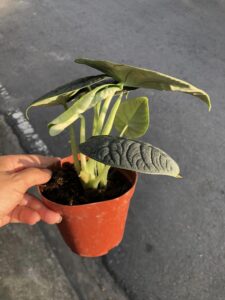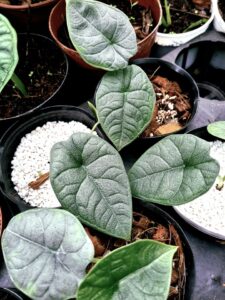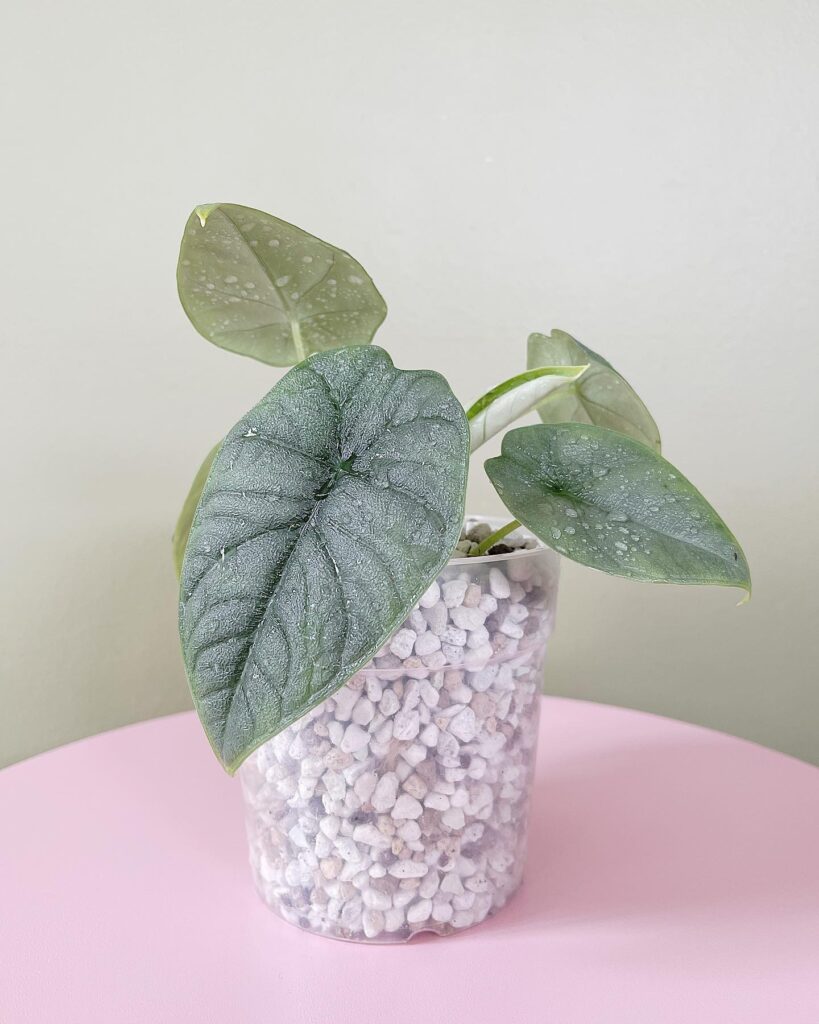Basic Information
Alocasia Melo is a stunning houseplant with unique foliage resembling a walnut’s skin. It’s perfect for plant enthusiasts looking for something out of the ordinary. To grow it successfully, replicate its native environment.



Light
Alocasia Melo flourishes in bright, indirect light, miming its natural rainforest habitat. While it can tolerate less light, it grows best with sufficient indirect sunlight. Direct sunlight should be avoided as it could damage the plant’s unique leaves. For optimal light balance, placing it near a north or east-facing window is advisable.
Water
Good drainage is crucial to maintain ideal moisture for Alocasia Melo. Consistent watering is necessary, but overwatering can cause root rot. Let the top layer of soil dry out between waterings, and be careful during less sunny or cooler periods. Use well-draining soil and pots to manage moisture effectively and maintain healthy roots.
Soil
Alocasia Melo requires well-draining soil that has enough aeration to retain moisture. To provide the ideal environment for its roots, a combination of peat, perlite, and orchid bark can be used. It is necessary to amend the standard potting soil with these materials to prevent soil compaction and excess moisture retention. Additionally, to promote the absorption of nutrients, the soil should be slightly acidic, which is essential for the overall health of it.
Tip: A chunky aroid mix is suitable for home use.
Temperature
The Alocasia Melo thrives in temperatures between 60-85°F (16-29°C) that are warm and consistent, which is reflective of its tropical origins. Exposure to cold drafts or sudden temperature changes can be harmful to the plant, causing stress and potentially leading to dormancy. It is important to maintain a stable temperature around the plant to avoid any issues related to temperature fluctuations. During colder months, it is essential to take extra care and ensure the plant is not exposed to temperatures outside of its preferred range.
Humidity
The Alocasia Melo plant thrives in high humidity, which is similar to the humidity levels in its natural rainforest habitat. In order to promote the plant’s healthy growth and leaf condition, it is recommended to maintain humidity levels of around 75% during the day and even higher at night. To achieve this, you can use a humidifier, pebble trays, or group plants together. Inadequate moisture in the air can lead to problems such as brown leaf tips, which are a common sign of low humidity levels.
Fertilizer
Monthly fertilization with a balanced NPK fertilizer or organic options like seaweed or fish emulsion supports healthy growth in Alocasia Melo during the growing season. Reduce or stop fertilization in colder months. Avoid over-fertilization and follow recommended dosages and frequencies.
Growth Rate
Alocasia Melo is a small plant that grows at a moderate pace, reaching a height of approximately 20-25 inches. If given proper care and optimal growing conditions, it will steadily increase in size over time. However, if it is not grown in the right conditions, it may slow down or even become dormant.
Pet Safety
Alocasia Melo is toxic if ingested by pets or humans. Keep it out of their reach and seek immediate medical attention if ingested. Pet owners should be careful with its placement.
Grow in Semi-Hydro
- Alocasia plants excel in Semi-hydroponics (LECA/Pon) due to their natural inclination for root growth and humidity.
- Successfully transitioning Alocasia to Semi-hydroponics is enhanced with a Nutrient Stagnant Wicking (NSW) setup.
- Alocasia roots adapt seamlessly to the water in LECA/Pon, with quick resolution of any root hair issues in NSW setups.
- Fertilizer includes a nutrient mix concentration of approximately 800-1000ppm.
- These plants are versatile in different temperature and humidity settings, thriving in controlled environments.
- Long-term care involves maintaining a constant water reservoir and performing occasional system flushes for sustained growth.
Tips
- Regular treatment with horticultural oils like neem oil can help prevent pest infestations, a common issue in humid conditions.
- Cleaning the leaves with a damp cloth not only keeps the plant looking attractive but also supports photosynthesis.
- Alocasia Melo prefers to be slightly root-bound; thus, repotting should be done only when necessary.
Caring for Alocasia Melo is rewarding. With proper care, it will add charm to any indoor garden. Mimic its natural habitat for best results.
Happy planting! 🌱


